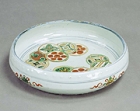Japanese Gallery (Honkan) Room 14
March 30, 2010 (Tue) - May 30, 2010 (Sun)
Overglaze enamel wares are produced by firing porcelain (with or without underglaze blue designs) at high temperatures, applying colored enamels, and then firing the wares a second time in a smaller specialized kiln. In China, these are known as wucai ("five-colour") wares.
At the Jingdezhen kilns in China during the late Ming and early Qing dynasties, a rich variety of wucai porcelain wares were produced, including the Tianqi, Shonzui and Nanjing types, and a great many were exported.
In the early Edo period (1603-1868), techniques for firing white porcelain were transmitted from Korea to the Hizen-Arita domain in Kyushu, Japan. Chinese overglaze enamel techniques were subsequently introduced in the mid-17th century, and creative adaptations of a range of wucai styles began to flourish.
Early Japanese overglaze enamel wares include so-called Kokutani wares, named after their perceived origin in Kutani, in Japan's former Kaga province. Other types include Shonzui-de (lit., "in the Shonzui style"), a Japanese interpretation of Chinese Shonzui-type overglaze enamel wares with a distinctive warmth, and the widely produced gosai-de (lit., "in the five-colour style") type. Gosai-de wares drew from the color and texture of Chinese Nanjing- and Kangxi-type overglaze enamel designs and were distinctive for their rich colors and bold composition.
Comparison of Chinese wucai and Japanese early overglaze enamel wares highlights their mutual influence and the intrinsic link between reproduction and creativity.

